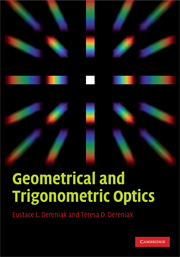Book contents
- Frontmatter
- Contents
- Preface
- 1 Light propagation
- 2 Reflections and refractions at optical surfaces
- 3 Image formation
- 4 Mirrors and prisms
- 5 Curved optical surfaces
- 6 Thin lenses
- 7 Thick lenses
- 8 Mirrors
- 9 Optical apertures
- 10 Paraxial ray tracing
- 11 Aberrations in optical systems
- 12 Real ray tracing
- Appendix A Linear prism dispersion design
- Appendix B Linear mixing model
- Appendix C Nature's optical phenomena
- Appendix D Nomenclature for equations
- Appendix E Fundamental physical constants and trigonometric identities
- Glossary
- Index
- References
9 - Optical apertures
Published online by Cambridge University Press: 06 July 2010
- Frontmatter
- Contents
- Preface
- 1 Light propagation
- 2 Reflections and refractions at optical surfaces
- 3 Image formation
- 4 Mirrors and prisms
- 5 Curved optical surfaces
- 6 Thin lenses
- 7 Thick lenses
- 8 Mirrors
- 9 Optical apertures
- 10 Paraxial ray tracing
- 11 Aberrations in optical systems
- 12 Real ray tracing
- Appendix A Linear prism dispersion design
- Appendix B Linear mixing model
- Appendix C Nature's optical phenomena
- Appendix D Nomenclature for equations
- Appendix E Fundamental physical constants and trigonometric identities
- Glossary
- Index
- References
Summary
Although an optical design goal is to collect as much light as possible, the amount of light which actually enters optical systems is a small fraction of the light which radiates off the object being viewed. The only usable light in an optical system is the light which enters the system at appropriate angles to reach the image location. Optical apertures limit the amount of light that enters the system, and also limit the area of the recorded image. Stops determine both the field of view and the illumination within the image. The field stop determines the field of view, which in turn determines how much of the object can be seen through the optical system. The field of view is calculated as the maximum angle from the optical axis at which light can enter and pass through the system. Image illumination is limited by aperture stops that constrict the bundle of light rays entering the system. Rays far from the optical axis, or those entering the system at too steep an angle, will not reach the image plane. Image illumination determines whether the image can be detected by an eye, a recording medium, or a two-dimensional detector array.
A stop (sometimes called a diaphragm) can be visualized as an opaque plate with a circular hole, akin to a metal washer or window in a building. There are two types of stops in optical systems, and they are named according to their functions within the system.
- Type
- Chapter
- Information
- Geometrical and Trigonometric Optics , pp. 226 - 254Publisher: Cambridge University PressPrint publication year: 2008



